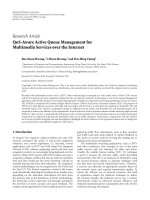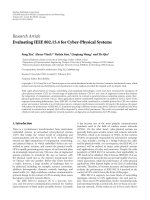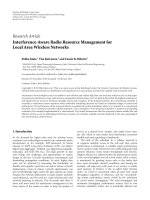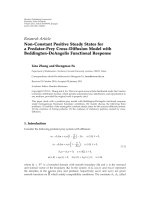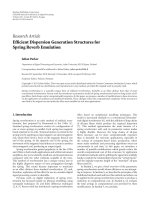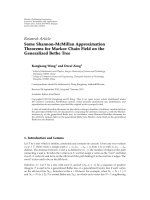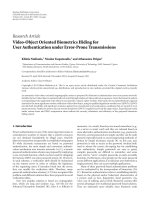Báo cáo hoa học: " Research Article Impulsive Periodic Boundary Value Problems for Dynamic Equations on Time Scale" pptx
Bạn đang xem bản rút gọn của tài liệu. Xem và tải ngay bản đầy đủ của tài liệu tại đây (500.13 KB, 10 trang )
Hindawi Publishing Corporation
Advances in Difference Equations
Volume 2009, Article ID 603271, 10 pages
doi:10.1155/2009/603271
Research Article
Impulsive Periodic Boundary Value Problems for
Dynamic Equations on Time Scale
Eric R. Kaufmann
Department of Mathematics & Statistics, University of Arkansas at Little Rock,
Little Rock, AR 72204, USA
Correspondence should be addressed to Eric R. Kaufmann,
Received 31 March 2009; Accepted 20 May 2009
Recommended by Victoria Otero-Espinar
Let
T be a periodic time scale with period p such that 0,t
i
,T mp ∈ T,i 1, 2, ,n, m ∈ N,
and 0 <t
i
<t
i1
. Assume each t
i
is dense. Using Schaeffer’s theorem, we show that the
impulsive dynamic equation y
Δ
t−aty
σ
tft, yt,t∈ T,yt
i
yt
−
i
It
i
,yt
i
,i
1, 2, ,n,y0yT, where yt
±
i
lim
t → t
±
i
yt, yt
i
yt
−
i
,andy
Δ
is the Δ-derivative on T,
has a solution.
Copyright q 2009 Eric R. Kaufmann. This is an open access article distributed under the Creative
Commons Attribution License, which permits unrestricted use, distribution, and reproduction in
any medium, provided the original work is properly cited.
1. Introduction
Due to their importance in numerous application, for example, physics, population
dynamics, industrial robotics, optimal control, and other areas, many authors are studying
dynamic equations with impulse effects; see 1–19 and references therein.
The primary motivation for this work are the papers by Kaufmann et al. 9 and Li et
al. 12.In9, the authors used a fixed point theorem due to Krasnosel’ski
˘
ı to establish the
existence theorems for the impulsive dynamic equation:
y
Δ
t
−a
t
y
σ
t
f
t, y
t
,t∈
0,T
∩ T,
y
t
i
y
t
−
i
I
t
i
,y
t
i
,i 1, 2, ,n,
y
0
0,
1.1
where yt
±
i
lim
t → t
±
i
yt, and y
Δ
is the Δ-derivative on T.
2 Advances in Difference Equations
In 12, the authors gave sufficient conditions for the existence of solutions for the
impulsive periodic boundary value problem equation:
u
t
λu
t
f
t, u
t
,
u
t
k
u
t
−
k
I
k
u
t
k
,k 1, 2, ,p,
u
0
u
T
,
1.2
where λ ∈ R,λ
/
0,T > 0, and 0 t
0
<t
1
< ··· <t
p
<t
p1
T. This paper extends and
generalized the above results to dynamic equations on time scales.
We assume the reader is familiar with the notation and basic results for dynamic
equations on time scales. While the books 20, 21 are indispensable resources for those who
study dynamic equations on time scales, these manuscripts do not explicitly cover the concept
of periodicity. The f ollowing definitions are essential in our analysis.
Definition 1.1 see 8. We say that a time scale T is periodic if there exist a p>0 such that if
t ∈ T, then t ± p ∈ T. For T
/
R, the smallest positive p is called the period of the time scale.
Example 1.2. The following time scales are periodic:
1 T hZ has period p h,
2 T R,
3 T
∞
k−∞
2k − 1h, 2kh,h>0 has period p 2h,
4 T {t k − q
m
: k ∈ Z,m∈ N
0
}, where 0 <q<1, has period p 1.
Remark 1.3. All periodic time scales are unbounded above and below.
Definition 1.4. Let T
/
R be a periodic time scale with period p. We say that the function f :
T → R is periodic with period T if there exists a natural number n such that T np, ft±T
ft for all t ∈ T and T is the smallest number such that ft ± Tft.
If T R, we say that f is periodic with period T>0ifT is the smallest positive number
such that ft ± Tft for all t ∈ T.
Remark 1.5. If T is a periodic time scale with period p, then σt ± npσ
t ± np.
Consequently, the graininess function μ satisfies μt±npσt±np−t±npσt −t μt
and so, is a periodic function with period p.
Let T be a periodic time scale with period p such that 0,t
i
,T ∈ T,fori 1, 2, ,n,
where T mp for some m ∈ N,0 <t
i
<t
i1
, and assume that each t
i
is dense in T for
each i 1, 2, ,n. We show the existence of solutions for the nonlinear periodic impulsive
dynamic equation:
y
Δ
t
−a
t
y
σ
t
f
t, y
t
,t∈ T,
y
t
i
y
t
−
i
I
t
i
,y
t
i
,i 1, 2, ,n,
y
0
y
T
,
1.3
where yt
±
i
lim
t → t
±
i
yt, and yt
i
yt
−
i
. Define 0,T{t ∈ T :0≤ t ≤ T} and note that
the intervals a, b, a, b, and a, b are defined similarly.
Advances in Difference Equations 3
In Section 2 we present some preliminary ideas that will be used in the remainder of
the paper. In Section 3 we give sufficient conditions for the existence of at least one solution
of the nonlinear problem 1.3.
2. Preliminaries
In this section we present some important concepts found in 20, 21 that will be used
throughout the paper. We also define the space in which we seek solutions, state Schaeffer’s
theorem, and invert the linearized dynamic equation.
A function p : T → R is said to be regressive provided 1 μtpt
/
0 for all t ∈ T
κ
.The
set of all regressive rd-continuous functions f : T → R is denoted by R.
Let p ∈Rand μt
/
0 for all t ∈ T.Theexponential function on T, defined by
e
p
t, s
exp
t
s
1
μ
z
Log
1 μ
z
p
z
Δz
, 2.1
is the solution to the initial value problem y
Δ
pty, ys1. Other properties of the
exponential function are given in the following lemma, 20, Theorem 2.36.
Lemma 2.1. Let p ∈R.Then
i e
0
t, s ≡ 1 and e
p
t, t ≡ 1;
ii e
p
σt,s1 μtpte
p
t, s;
iii 1/e
p
t, se
p
t, s where, pt−pt/1 μtpt;
iv e
p
t, s1/e
p
s, te
p
s, t;
v e
p
t, se
p
s, re
p
t, r;
vi1/e
p
·,s
Δ
−pt/e
σ
p
·,s.
Define t
n1
≡ T and let J
0
0,t
1
. For i 1, 2, ,n,letJ
i
t
i
,t
i1
. Define
PC
y : T −→ R | y
t ± T
y
t
,y ∈ C
J
i
,y
t
±
i
exist and y
t
−
i
y
t
i
,i 1, ,n
,
2.2
and
PC
1
y : T → R | y
t ± T
y
t
,y∈ C
1
J
i
,i 1, ,n
2.3
where CJ
i
is the space of all real-valued continuous functions on J
i
,andC
1
J
i
is the
space of all continuously delta-differentiable functions on J
i
.ThesetPC is a Banach space
when it is endowed with the supremum norm:
u max
0≤i≤n
{
u
i
}
, 2.4
where u
i
sup
t∈J
i
|ut|.
4 Advances in Difference Equations
We employ Schaeffer’s fixed point theorem, see 22, to prove the existence of a
periodic solution.
Theorem 2.2 Schaeffer’s Theorem. Let S be a normed linear space and let the operator F : S → S
be compact. Define
H
F
y ∈ S | y μF
y
,μ∈
0, 1
. 2.5
Then either
i the set HF is unbounded, or
ii the operator F has a fixed point in S.
The following conditions hold throughout the paper:
A a ∈Ris periodic with period T; at Tat for all t ∈ T.
F f
∈ CT × R, R and for all t ∈ T, ft T, yt T ft, yt.
Furthermore, to ensure that the boundary value problem is not at resonance, we assume that
η e
a
T, 0 < 1.
Consider the linear boundary value problem:
y
Δ
t
−a
t
y
σ
t
ζ
t
,t∈ T,
y
t
i
y
t
−
i
I
t
i
,y
t
i
,i 1, 2, ,n,
y
0
y
T
,
2.6
where ζ ∈ PC. Our first result inverts the operator 2.6.
Lemma 2.3. The function y ∈ PC
1
is a solution of 2.6 if and only if y ∈ PC is a solution of
y
t
T
0
G
t, s
ζ
s
Δs
n
i1
G
t, t
i
I
t
i
,y
t
i
, 2.7
where
G
t, s
1
1 − η
⎧
⎨
⎩
e
a
t, s
, 0 ≤ s ≤ t ≤ T,
ηe
a
t, s
, 0 ≤ t<s≤ T.
2.8
Proof. It is easy to see that if y ∈ PC
1
is a solution of 2.6, then for t ∈ 0,T, we have
y
t
e
a
t, 0
y
0
t
0
e
a
t, s
ζ
s
Δs
n
{
i|t
i
≤t
}
e
a
t, t
i
I
t
i
,y
t
i
. 2.9
Advances in Difference Equations 5
Apply the periodic boundary condition y0yT to obtain
y
0
ηy
0
T
0
e
a
T, s
ζ
s
Δs
n
i1
e
a
T, t
i
I
t
i
,y
t
i
. 2.10
Since η
/
1, we can solve the above equation for y0.Thus,
y
0
1
1 − η
T
0
e
a
T, s
ζ
s
Δs
n
i1
e
a
T, t
i
I
t
i
,y
t
i
. 2.11
Substitute 2.11 into 2.9. Since y ∈ PC
1
, we have, for all t ∈ T,
y
t
e
a
t, 0
1 − η
T
0
e
a
T, s
ζ
s
Δs
n
i1
e
a
T, t
i
I
t
i
,y
t
i
t
0
e
a
t, s
ζ
s
Δs
{i|t
i
≤t}
e
a
t, t
i
I
t
i
,y
t
i
.
2.12
We can rewrite this equation as follows:
y
t
e
a
t, 0
1 − η
T
t
e
a
T, s
ζ
s
Δs
e
a
t, 0
1 − η
{i|t
i
>t}
e
a
t, t
i
I
t
i
,y
t
i
t
0
e
a
t, 0
e
a
T, s
1 − η
e
a
t, s
ζ
s
Δs
{i|t
i
≤t}
e
a
t, 0
e
a
T, t
i
1 − η
e
a
t, t
i
I
t
i
,y
t
i
.
2.13
Since e
a
t, 0e
a
T, se
a
T, 0e
a
t, s, then
y
t
T
t
e
a
T, 0
e
a
t, s
1 − η
ζ
s
Δs
t
0
e
a
t, s
1 − η
ζ
s
Δs
{i|t
i
>t}
e
a
T, 0
e
a
t, s
1 − η
I
t
i
,y
t
i
{i|t
i
≤t}
e
a
t, t
i
1 − η
I
t
i
,y
t
i
.
2.14
That is, y satisfies 2.7.
The converse follows trivially and the proof is complete.
6 Advances in Difference Equations
3. The Nonlinear Problem
In this section we give sufficient conditions for the existence of periodic solutions of 1.3.To
this end, define the operator N : PC → PC by
Ny
t
T
0
G
t, s
f
s, y
s
Δs
n
i1
G
t, t
i
I
t
i
,y
t
i
. 3.1
Then y is a solution of 1.3 if and only if y is a fixed point of N. A standard application of
the Arzel
`
a-Ascoli theorem yields that N is compact.
Our first result is an existence and uniqueness theorem.
Theorem 3.1. Suppose there exist constants E
i
,i 1, ,n,and L for which
f
t, y
− f
t, x
≤ L
y − x
, ∀t ∈ T, 3.2
and
I
t
i
,y
t
i
− I
t
i
,x
t
i
≤ E
i
y
t
i
− x
t
i
,i 1, 2, ,n, 3.3
and such that
max
t∈0,T
L
T
0
|
e
a
t, s
|
Δs
n
i1
E
i
|
e
a
t, t
i
|
< 1 − η. 3.4
Then there exists a unique solution to 1.3.
Proof. We will show that there exists a unique solution yt of 3.1.ByLemma 2.3 this
solution is the unique solution of 1.3.
Let y, x ∈ PC. Then for all t ∈ T
Ly
t
− Lx
t
≤
T
0
|
G
t, s
|
f
s, y
s
− f
s, x
s
Δs
n
i1
|
G
t, t
i
|
I
t
i
,y
t
i
− I
t
i
,x
t
i
≤
y − x
1 − η
L
T
0
e
a
t, s
Δs
n
i1
E
i
|
e
a
t, t
i
|
< y − x.
3.5
Hence, Ly − Lx≤y − x. By the Contraction Mapping Principal, there exists a unique
solution of 3.1 and the proof is complete.
Advances in Difference Equations 7
Our next two results utilize Theorem 2.2 to establish the existence of solutions of 1.3.
Theorem 3.2. Assume there exist functions g
1
,g
2
,g
3
,g
4
: PC → PC with
α
1
≡ max
t∈0,T
t
0
|
e
a
t, s
|
g
1
s
Δs<∞,
β
1
≡ max
t∈0,T
t
0
|
e
a
t, s
|
g
2
s
Δs<∞,
α
2
≡ max
t∈0,T
n
i1
|
e
a
t, t
i
|
g
3
t
i
< ∞,
β
2
≡ max
t∈0,T
n
i1
|
e
a
t, t
i
|
g
4
t
i
< ∞,
3.6
such that
f
t, y
≤ g
1
t
g
2
t
y
,t∈ T,y ∈ R,
I
t, y
≤ g
3
t
g
4
t
y
,t∈ T,y ∈ R.
3.7
Suppose that η β
1
β
2
< 1. Then there exists at least one solution of 1.3.
Proof. Define
H
N
y ∈ PCy
t
μNy
t
,μ∈
0, 1
,t∈ T
, 3.8
and let y ∈ HN.WeshowHN is bounded by a constant that depends only on the
constants α
1
,α
2
,β
1
,β
2
,andη. For all t ∈ T,
y
t
≤ μ
T
0
|
G
t, s
|
f
t, y
s
Δs μ
n
i1
|
G
t, t
i
|
I
t
i
,y
t
i
≤
μ
1 − η
T
0
|
e
a
t, s
|
g
1
s
g
2
s
y
Δs
μ
1 − η
n
i1
|
e
a
t, t
i
|
g
3
t
i
g
4
t
i
y
≤
1
1 − η
T
0
|
e
a
t, s
|
g
1
s
Δs
n
i1
|
e
a
t, t
i
|
g
3
t
i
y
1 − η
T
0
|
e
a
t, s
|
g
2
s
Δs
n
i1
|
e
a
t, t
i
|
g
4
t
i
≤
α
1
α
2
1 − η
y
β
1
β
2
1 − η
.
3.9
8 Advances in Difference Equations
Consequently,
y
1 − η − β
1
− β
2
1 − η
≤
α
1
α
2
1 − η
, 3.10
which implies that y≤α
1
α
2
/1 − η − β
1
− β
2
. We have that if y ∈ HN, then y is
bounded by the constant α
1
α
2
/1 − η − β
1
− β
2
. The set HN is bounded and so by
Schaeffer’s theorem, the operator N has a fixed point. This fixed point is a solution of 1.3
and the proof is complete.
In our next theorem we assume that f and I are sublinear at infinity with respect to
the second variable.
Theorem 3.3. Assume that
F
1
lim
|y|→∞
ft, y/y0, uniformly, and
I lim
|y|→∞
It, y/y0, uniformly.
Then there exists at least one solution of the boundary value problem 1.3.
Proof. Suppose that the set
H
N
y ∈ PC | y
t
μNy
t
,μ∈
0, 1
,t∈ T
3.11
is unbounded. Then there exists sequences {y
k
}
∞
k1
and {μ
k
}
∞
k1
,withy
k
>kand μ
k
∈ 0, 1,
such that
y
k
t
μ
k
T
0
G
t, s
f
s, y
k
s
Δs μ
k
n
i1
G
t, t
i
I
t
i
,y
t
i
. 3.12
Define v
k
ty
k
t/y
k
,t∈ T. Then v
k
1,k 1, 2, ,and
v
k
t
μ
k
T
0
G
t, s
f
s, y
k
s
y
k
Δs μ
k
n
i1
G
t, t
i
I
t
i
,y
t
i
y
k
. 3.13
By conditions F
1
and I we have
f
s, y
k
s
y
k
−→ 0ask −→ ∞ , 3.14
I
t
i
,y
t
i
y
k
−→ 0ask −→ ∞ . 3.15
From 3.13, 3.14,and3.15, we have that
|
v
k
t
|
≤
T
0
|
G
t, s
|
f
s, y
k
s
y
k
Δs
n
i1
|
G
t, t
i
|
I
t
i
,y
t
i
y
k
−→ 0,
3.16
Advances in Difference Equations 9
as k →∞, which contradicts v
k
1 for all k. Thus the set HN is bounded. By
Theorem 2.2, the operator N : PC → PC has a fixed point. This fixed point is a solution
of 1.3 and the proof is complete.
The following corollary is an immediate consequences of Theorem 3.3
Corollary 3.4. Assume that f and I are bounded. Then there exists at least one solution of 1.3.
References
1 D. D. Ba
˘
ınov and P. S. Simeonov, Systems with Impulse Effect: Stability, Theory and Application, Ellis
Horwood Series: Mathematics and Its Applications, Ellis Horwood, Chichester, UK, 1989.
2 M. Benchohra, J. Henderson, S. K. Ntouyas, and A. Ouahab, “On first order impulsive dynamic
equations on time scales,” Journal of Difference Equations and Applications, vol. 10, no. 6, pp. 541–548,
2004.
3 F. Geng, Y. Xu, and D. Zhu, “Periodic boundary value problems for first-order impulsive dynamic
equations on time scales,” Nonlinear Analysis: Theory, Methods & Applications, vol. 69, no. 11, pp. 4074–
4087, 2008.
4 J. R. Graef and A. Ouahab, “Extremal solutions for nonresonance impulsive functional dynamic
equations on time scales,” Applied Mathematics and Computation, vol. 196, no. 1, pp. 333–339, 2008.
5 D. Guo, “Existence of positive solutions for nth-order nonlinear impulsive singular integro-
differential equations in Banach spaces,” Nonlinear Analysis: Theory, Methods & Applications, vol. 68,
no. 9, pp. 2727–2740, 2008.
6 D. Guo, “A class of second-order impulsive integro-differential equations on unbounded domain in
a Banach space,” Applied Mathematics and Computation, vol. 125, no. 1, pp. 59–77, 2002.
7 D. Guo, “Multiple positive solutions of a boundary value problem for nth-order impulsive integro-
differential equations in Banach spaces,” Nonlinear Analysis: Theory, Methods & Applications, vol. 63,
no. 4, pp. 618–641, 2005.
8 E. R. Kaufmann and Y. N. Raffoul, “Periodic solutions for a neutral nonlinear dynamical equation on
a time scale,” Journal of Mathematical Analysis and Applications, vol. 319, no. 1, pp. 315–325, 2006.
9 E. R. Kaufmann, N. Kosmatov, and Y. N. Raffoul, “Impulsive dynamic equations on a time scale,”
Electronic Journal of Differential Equations, vol. 2008, no. 67, pp. 1–9, 2008.
10 E. R. Kaufmann, N. Kosmatov, and Y. N. Raffoul, “A second-order boundary value problem with
impulsive effects on an unbounded domain,” Nonlinear Analysis: Theory, Methods & Applications,vol.
69, no. 9, pp. 2924–2929, 2008.
11 V. Lakshmikantham, D. D. Ba
˘
ınov,andP.S.Simeonov,Theory of Impulsive Differential Equations, vol. 6
of Series in Modern Applied Mathematics, World Scientific, Teaneck, NJ, USA, 1994.
12 J. Li, J. J. Nieto, and J. Shen, “Impulsive periodic boundary value problems of first-order differential
equations,” Journal of Mathematical Analysis and Applications, vol. 325, no. 1, pp. 226–236, 2007.
13 X. Liu, “Nonlinear boundary value problems for first order impulsive integro-differential equations,”
Applicable Analysis, vol. 36, no. 1-2, pp. 119–130, 1990.
14 J. J. Nieto, “Basic theory for nonresonance impulsive periodic problems of first order,” Journal of
Mathematical Analysis and Applications, vol. 205, no. 2, pp. 423–433, 1997.
15 C. Pierson-Gorez, “Impulsive differential equations of first order with periodic boundary conditions,”
Differential Equations and Dynamical Systems, vol. 1, no. 3, pp. 185–196, 1993.
16 Y. V. Rogovchenko, “Impulsive evolution systems: main results and new trends,” Dynamics of
Continuous, Discrete and Impulsive Systems, vol. 3, no. 1, pp. 57–88, 1997.
17 A. M. Samo
˘
ılenko and N. A. Perestyuk, Impulsive Differential Equations, vol. 14 of World Scientific Series
on Nonlinear Science, Series A: Monographs and Treatises, World Scientific, River Edge, NJ, USA, 1995.
18 A. S. Vatsala and Y. Sun, “Periodic boundary value problems of impulsive differential equations,”
Applicable Analysis, vol. 44, no. 3-4, pp. 145–158, 1992.
19 D B. Wang, “Positive solutions for nonlinear first-order periodic boundary value problems of
impulsive dynamic equations on time scales,” Computers & Mathematics with Applications, vol. 56, no.
6, pp. 1496–1504, 2008.
10 Advances in Difference Equations
20 M. Bohner and A. Peterson, Dynamic Equations on Time Scales: An Introduction with Applications,
Birkh
¨
auser, Boston, Mass, USA, 2001.
21 M. Bohner and A. Peterson, Advances in Dynamic Equations on Time Scales,Birkh
¨
auser, Boston, Mass,
USA, 2003.
22 D. R. Smart, Fixed Point Theorems, Cambridge University Press, London, UK, 1980.

